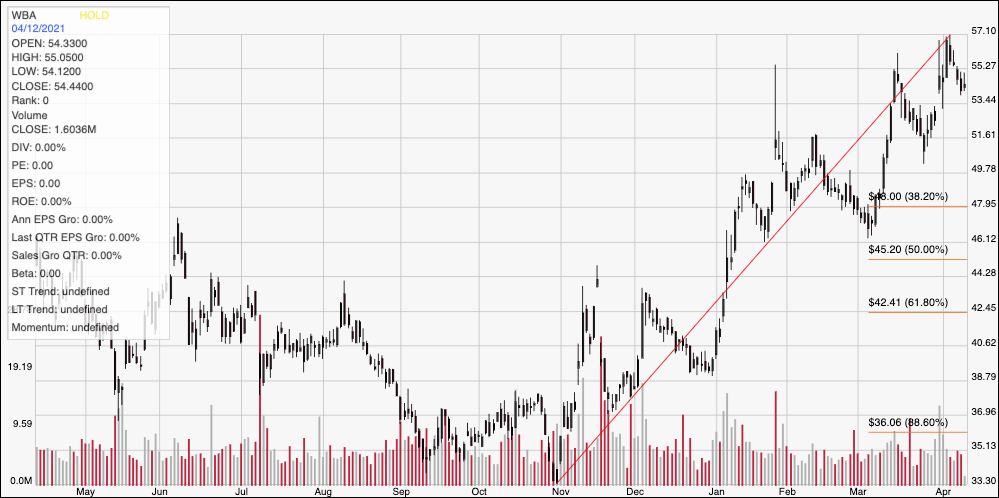Throughout the past year, stocks in the health care business have drawn a lot of attention from investors and analysts. That includes stocks in the Pharmacy/Drugstore industry; these were names, like Walgreens Boots Alliance (WBA)and CVS Corporation (CVS) that worked actively in the early stages of the crisis to provide a critical piece of the testing puzzle, providing COVID-19 testing spaces outside its stores with solutions that included drive-through tests. As vaccine candidates moved from trial to emergency use authorization, they’ve also helped provide the next piece of the puzzle as a place you could go to get vaccinated.
Long-term demographic trends are generally favorable for pharmacies, even outside the scope of the pandemic. Continued aging of the Baby Boomer generation, and with Generation X following not far behind in the next decade or two, means that demand for prescription drugs is expected to only increase. When you add in other fundamental factors like WBA’s long-standing status as a dividend aristocrat (members of the S&P 500 Index that have paid a dividend for 25 consecutive years or more) and healthy Free Cash Flow, it is interesting to look at the stock’s price performance.
While most stocks in the Healthcare sector (including CVS) saw a nice rebound beginning in March of last year, along with the rest of the market, WBA’s stock extended a multiyear downward trend that saw the stock touch a new low around $33 in November 2020. The stock has since picked up a lot of bullish momentum, increasing in price to a recent peak at around $57 per share, and now sitting just a little below that point. With some interesting strengths in the company’s fundamental profile, the natural question to ask is whether that big move up in price means that the value proposition has played out. Let’s find out.
Fundamental and Value Profile
Walgreens Boots Alliance, Inc. is a holding company. The Company is a pharmacy-led health and wellbeing company. The Company operates through three segments: Retail Pharmacy USA, Retail Pharmacy International and Pharmaceutical Wholesale. The Retail Pharmacy USA segment consists of the Walgreen Co. (Walgreens) business, which includes the operation of retail drugstores, care clinics and providing specialty pharmacy services. The Retail Pharmacy International segment consists primarily of the Alliance Boots pharmacy-led health and beauty stores, optical practices and related contract manufacturing operations. The Pharmaceutical Wholesale segment consists of the Alliance Boots pharmaceutical wholesaling and distribution businesses. The Company’s portfolio of retail and business brands includes Walgreens, Duane Reade, Boots and Alliance Healthcare, as well as global health and beauty product brands, including No7, Botanics, Liz Earle and Soap & Glory. WBA has a current market cap of $47 billion.
Earnings and Sales Growth: Over the last twelve months, earnings declined by almost -7.9%, while sales were -8.5% lower. In the last quarter, earnings improved by 14.75% while sales declined -9.72%. The company’s margin profile is normally razor-thin, but during the last year turned negative; over the last twelve months Net Income was -0.45% of Revenues. In the last quarter, however Net income returned to positive territory, translating to 3.13% in the last quarter.
Free Cash Flow: WBA has free cash flow of a little over $5 billion over the last twelve months. This number has declined from August of 2018, when it was about $6.9 billion; but it also marks an improvement from mid-2020, when Free Cash Flow had declined to about $4.8 billion. The current number also translates to a Free Cash Flow Yield of 10.76%.
Debt to Equity: the company’s debt to equity ratio is .51, which is a conservative number, but doesn’t tell an accurate story about the company’s financial flexibility. Long-term debt in the last quarter was almost $11 billion versus $1.03 billion in cash and liquid assets. Liquidity is improving, as cash was $469 million about six months ago. The company’s narrow, but strengthening margin profile along with improving liquidity suggests debt management should not be a concern.
Dividend: WBA pays an annual dividend of $1.87 per share, which translates to an annual yield of 3.45% at the stock’s current price.
Price/Book Ratio: there are a lot of ways to measure how much a stock should be worth; but I like to work with a combination of Price/Book and Price/Cash Flow analysis. Together, these measurements provide a long-term, fair value target around $57 per share. That means the stock is only slightly undervalued, with about 5% upside from its current price.
Technical Profile
Here’s a look at the stock’s latest technical chart.
Current Price Action/Trends and Pivots: The chart above displays the stock’s price activity over the last year; the diagonal red line traces the stock’s upward trend from a late October low at around $33 to its recent high at around $57. It also provide the baseline for the Fibonacci retracement lines shown on the right side of the chart. Immediate resistance is at $57, while the stock appears to be looking for support somewhere between $54 and $53. If that support doesn’t hold, next support is around $51.50, with additional downside to around $48 where the 38.2% retracement sits. A push above $57 could see the stock test its next high in the $63 range based on the distance between the last support bounce in late March to its peak earlier this month.
Near-term Keys: WBA’s valuation metrics aren’t compelling right now, which means that despite the company’s improving fundamentals, I can’t call the stock a smart long-term opportunity. If you prefer to focus on short-term trades rather than long-term opportunities, you could use a drop below $51.50 as a signal to consider shorting the stock or working with put options, with an eye on a profit target around $48. If the stock can find support between $53 and $54 and bounce higher, there could be an interesting signal to buy the stock or work with call options, using the stock’s peak at $57 as an interesting short-term profit target on a bullish trade.
